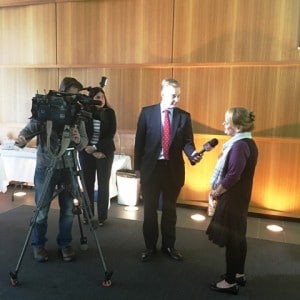Carole, 62 Retired business consultant who sustained multiple bone fractures, Glenning Valley, CENTRAL COAST NSW
 Retired business consultant, Carole, 62, Glenning Valley, Central Coast NSW, was diagnosed with osteopenia – a precursor to osteoporosis or brittle bones – in 2004, just after her 50th birthday.
Retired business consultant, Carole, 62, Glenning Valley, Central Coast NSW, was diagnosed with osteopenia – a precursor to osteoporosis or brittle bones – in 2004, just after her 50th birthday.
The news came as a huge shock to Carole, who had long subscribed to a healthy diet and exercise.
Carole has since sustained multiple bone fractures, including an excruciating fracture of several vertebrae in her lower spine, some compressing up to 60 per cent, resulting in a loss of five centimetres in height, and has had to learn to walk again to accommodate her new spinal alignment.
This is Carole’s story.
“My doctor had been nagging me for a while to undergo a bone mineral density test.
“So when I celebrated my 50th birthday in 2004, I finally agreed to have the test to mark this significant milestone in my life,” said Carole.
To her complete surprise however, the results revealed Carole was living with osteopenia in both her spine and her hips.
“I was shocked to receive the results because I’ve always maintained such a healthy, active lifestyle. For years I’ve attended the gym, eaten well and worked hard to maintain a healthy lifestyle.
“I also have no known family history of the disease, and I had minimal understanding of the disease back then – I mistakenly thought it was only a disease of the elderly. I never thought someone of my age could develop osteopenia,” said Carole.
After being diagnosed with osteopenia by her endocrinologist, Carole immediately commenced medication, various forms of which she has since tried.
Post- diagnosis, Carole spent the ensuing 10 years moving in and out of hospital emergency departments after fracturing multiple bones, including her wrist, ribs and sternum – each of which was treated as an individual break. During this period, she grew increasingly wary of sustaining further injury and bone re-fracture.
On March 17, 2015, while simply cleaning out a garden drain, Carole was startled by a lizard that jumped from her deck onto her shoulder. She jolted suddenly in response to the reptile.
“When the lizard landed on my shoulder, I was surprised, so moved abruptly. I didn’t scream, but rather, just reacted.”
This minor incident spurred a long and painful venture for Carole who, not long after, began to experience pain in her groin. After visiting her GP for professional advice, Carole was subsequently referred to several specialists who further examined her, searching for clues in her bowel, intestine and for other potential causes of the pain. In the interim, Carole continued to writhe in pain for three months.
On May 27, 2015, she was hospitalised, where she underwent a colonoscopy and further treatment to clean her intestines, and was discharged two days later.
The following Tuesday however, still in excruciating pain, Carole visited her GP and was referred to a back specialist, a gastroenterologist and a gynaecologist. After visiting the gynaecologist the following day, Carole was immediately admitted to hospital.
The hospital’s gastroenterologist performed some scans which revealed she had fractures in her spine and compression of up to 60 per cent in several vertebrae – the actual source of her ongoing, severe pain.
Carole spent the following three months hospitalised, while a long-term pain management regime was developed, and she regained mobility.
“I was in hospital and then in rehabilitation. My first round of rehabilitation went poorly however, and I fractured a few more bones in my spine as a result.”
After eventually returning home, Carole continued rehabilitation to rebuild the strength of her spine.
She describes the entire experience as “an extremely painful ordeal,” from initial misdiagnosis of her spinal fractures and vertebrae compression, to ineffective rehabilitation of her spinal fracture, and further compounded by her personal lack of understanding of osteopenia and osteoporosis.
“It was an extremely debilitating and painful time for me, and it has really impacted upon my life in so many ways.
“I’ve had to learn to walk again. I’ve also lost five centimetres in height due to the damage I sustained to my lower spine,” said Carole.
“You just don’t realise, or recognise, the damage that fractures can cause before they occur.”
Now aged 62, Carole visits her specialist every three months for ongoing monitoring and treatment.
“I see my specialist every three months, and I have a daily injection to manage my disease.
“Protecting my bones from re-fracture is my highest priority,” Carole said.
“My life has changed dramatically because of the fractures I’ve sustained.
“My bones have to be monitored very closely now, and I need to be very careful when performing simple, daily tasks, such as preparing a meal, hanging out washing, weeding the garden, or lifting relatively light weights, which could prove disastrous to my spine,” said Carole.
“Yet, despite all that I’ve endured to date, had I not been diagnosed with osteoporosis when I was, my situation could have been much worse.
“It’s time that people took their bone health very seriously, and recognised that by taking action sooner rather than later, painful fractures may be avoided,” Carole said.
Carole is a strong advocate of the new, online Know Your Bones health assessment tool, developed by the Garvan Institute of Medical Research and Osteoporosis Australia.
“This new online, fracture risk self-assessment tool is quick and easy to use, and provides the user with a simple report that they can print out and take to their doctor for further discussion and action, if required.
“I encourage every Australian adult to jump online and give it a go,” said Carole.
Take the bone health self-assessment tool today: www.knowyourbones.org.au
